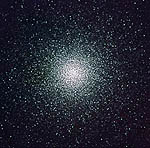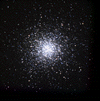Emission nebulae are clouds of high temperature gas. The atoms in the cloud
are energized by ultraviolet light from a nearby star and emit radiation as
they fall back into lower energy states (in much the same way as a neon
light). These nebulae are usually red because the predominant emission line
of hydrogen happens to be red (other colours are produced by other atoms, but
hydrogen is by far the most abundant). Emission nebulae are usually the
sites of recent and ongoing star formation.
Planetary nebulae are shells of gas thrown out by some stars near the end of
their lives. Our Sun will probably produce a planetary nebula in about 5
thousand million years. They have nothing at all to do with planets; the terminology
was invented because they often look a little like planets in small
telescopes.
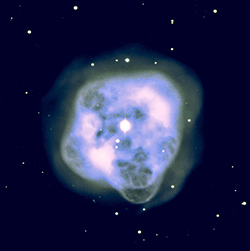
Description: ING web news release.
Date: 2017.
Credits: David Jones (Instituto de Astrofisica de Canarias).
Technical information:
Colour-composite image of the planetary nebula NGC 1514 obtained from narrowband Halpha+[N II] and [OIII] images taken using the Wide Field Camera (WFC) on the Isaac Newton Telescope (INT).
Available formats:
JPEG
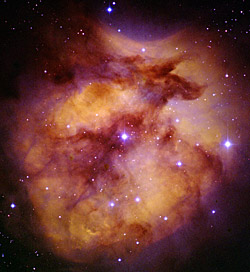
Description: ING web news release.
Date: 2015.
Credits: Anngel R. López-Sánchez, Australian Astronomical Observatory / Macquarie University.
Technical information:
Colour-composite (RGB) image of the Cocoon nebula obtained from a combination of wide- and narrow-band images taken using the Wide Field Camera (WFC) on the 2.5 m Isaac Newton Telescope. Only part of the CCD #4 is shown (click on the image for a full display). The following colour code was used: broad-band B image (blue), and narrow-band H. and H. images (green and red, respectively).
Available formats:
JPEG
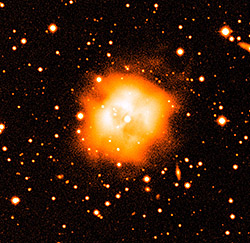
Description: ING web news release.
Date: 2015.
Credits: Romano Corradi (IAC).
Technical information:
1 hour exposure through filter Hα+[NII] using the WFC on the INT.
Available formats:
JPEG |
JPEG (inset) |
TIFF.
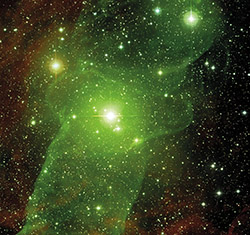
Description:
ING image release of Ou4 Nebula.
Date: 2014.
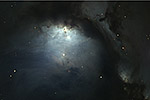
Description:
M78 Nebula.
Date: 2014.
Credits: Alexis Smith.
Technical information:
This image was obtained through the filters Harris R, Harris V and Harris B to match red, green and blue respectively. Each exposure time was 180 seconds.
Available formats: JPEG.
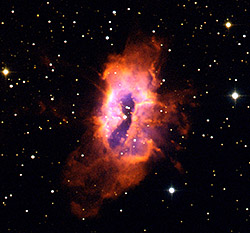
Description: ING image release of PN Sh2-71.
Date: 2013.
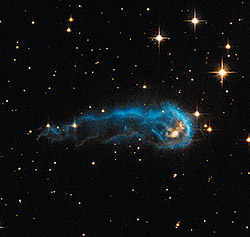
Description: ING image release of IRAS 20324+4057.
Date: 2013.
1:  2:
2:  3:
3: 
Description:
IC 1396B in the constellation Cepheus imaged in the red light from hydrogen atoms.
These images were obtained as part of the
INT/WFC
Photometric Hydrogen-Alpha Survey of the Northern Galactic Plane (IPHAS).
Date:
Image 1: 2005.
Image 2: 2011.
Image 3: 2013.
Credits:
Image 1: Nick Wright (University College London) and the IPHAS collaboration.
Image 2: Geert Barentsen & Jorick Vink (Armagh Observatory) & the IPHAS Collaboration.
Image 3: Nick Wright (University of Hertfordshire, SAO).
Technical information:
Image 1: Image obtained using the Wide-Field Camera on the Isaac Newton Telescope. The image scale is roughly 15 × 15 square arcminutes, with N to the left and E down.
Image 2: Image obtained using the Wide-Field Camera on the Isaac Newton Telescope. The image scale is 5 degrees roughly.
Image 3: ING image release.
Available formats:
Image 1: JPEG | TIFF | PDF (with text).
Image 2: JPEG | TIFF
Image 3: JPEG (8000×4000 pixels)

Description:
NGC 2359, better known as the Thor's Helmet nebula, is actually more like an interstellar bubble, blown as a fast wind from the bright, massive
star near the bubble's center sweeps through a surrounding molecular cloud. Known as a Wolf-Rayet star, the central star is an extremely hot giant thought to be in a brief,
pre-supernova stage of evolution. It lies about 15,000 light years from Earth in the constellation Canis Major, measuring about 30 light years.
Date: 2012.
Credits: Rafael Barrena (IAC) and Daniel López.
Technical information:
This image of the Thor's Helmet nebula or NGC 2359 was obtained using the Wide Field Camera on the Isaac Newton Telescope (INT).
It is a three-colour composite made from data collected using filters to isolate the light emitted by hydrogen alpha (H-alpha), doubly-ionised oxygen (OIII) and single-ionised sulfur
(SII) atoms, and coded in the image as red, green and blue respectively.
Available formats: JPEG | TIFF.

Description:
This image of the Rosette Nebula (NGC 2237) is thought to be the most-detailed ever produced. Compiled from data taken from IPHAS, the Isaac Newton Telescope Photometric Hydrogen-Alpha Survey of the Northern Galactic Plane, the image spans four square degrees,
about twenty times the size of the full moon.
Date: 2007.
Credits: Nick Wright (University College London) and the IPHAS collaboration.
Technical information: Image obtained using the Wide-Field Camera on the Isaac Newton Telescope. Resolution is 1 arcsecond per pixel, and North is up, east is left.
Available formats: JPEG (360K) | JPEG (1.1M) | JPEG (3.0M) | BMP (157M) | PDF (with text).

Description:
Dust lanes in the centre of the Rosette Nebula or NGC 2237. Size is 30×20 arcmin, north to the left, east is down.
This image was obtained as part of the IPHAS survey.
Date: 2005.
Credits: Nick Wright (University College London) on behalf of the IPHAS collaboration.
Technical information: Image obtained using the Wide-Field Camera on the Isaac Newton Telescope.
Available formats: JPEG (3593 K) | TIFF (26,723 K) | PDF (with text).
1 2
2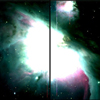 3
3 4
4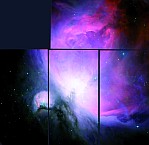
Description: This is the star-formation region M42, also known as the Orion nebula.
The gas and dust in the nebula emits light because it is irradiated by
nearby emerging stars. Located at a distance of about 1,600 light years, the Orion nebula is the
brightest diffuse nebula in the sky, visible to the naked eye. It is the main
part of a much larger cloud of gas and dust which extends over 10 degrees
well over half the constellation Orion.
Date: Images 1, 2: 1999. Image 3: 1995. Image 4: 2007.
Credits: Images 1, 2: Simon Tulloch (ING) and Nik Szymanek.
Image 3: ING Archive and Nik Szymanek. Image 4: Jonathan Irwin.
Technical information: Images 1 and 2 are 10s true-colour images using BVR imaging
on the WHT prime focus camera. Image 3: Jacobus Kapteyn Telescope, Tek CCD,
B, V and R filters. Image 4: Wide-Field Camera on the Isaac Newton Telescope.
Available formats:
Image 1: JPEG (167 K) | TIFF (1,045 K) | PDF (with text)
Image 2: JPEG (35 K)
Image 3: JPEG (125 K) | TIFF (12,390 K). Image 4: JPEG | TIFF

Title: M43 Nebula.
Description: M43 is actually a part of the Great Orion Nebula, M42, which is separated from the main nebula by an impressive, turbulent dark lane.
Date: 2002.
Credits: Nik Szymanek (University of Hertfordshire) and Simon Tulloch (ING).
Technical information: Wide-Field Camera on Isaac Newton Telescope. This is a 300 second exposure in H-alpha combined with colour information from an amateur CCD image.
Available formats: JPEG (261 K) | TIFF (4608 K) | PDF (with text).

Description: NGC 7635, the Bubble nebula. A massive star that is not
only bright and blue, but also emitting a fast stellar wind of ionized gas,
created this huge space bubble. The Bubble nebula is actually the smallest of
three bubbles surrounding massive star BD+602522, and part of gigantic bubble
network S162 created with the help of other massive stars. As fast moving
gas expands off BD+602522, it pushes surrounding sparse gas into a shell.
The energetic starlight then ionizes the shell, causing it to glow. The
Bubble Nebula is about 10 light-years across and
visible with a small telescope towards the constellation of Cassiopeia. PDF (with text).
Date: 1992.
Copyright: Malin-IAC-RGO.
Technical information: Photographic 3-colour composition from the
Isaac Newton Telescope.

Title: Fox Fur Nebula.
Description: The Fox Fur Nebula is part of the NGC 2264 region and it emits light because of the ultraviolet radiation generated by the blue stars of the nearby star cluster.
Date: 2010.
Credits: Rafael Barrena (IAC) and Pablo Rodríguez-Gil (ING).
Technical information: Wide-Field Camera on Isaac Newton Telescope. This is a 7×300 second exposure in H-alpha.
Available formats: JPEG.
1 2
2
Description: The Crescent Nebula (NGC 6888), which surrounds the Wolf-Rayet star PPM 84423 or HD192163, seen in Hydrogen-α emission. This was observed as part of the Isaac Newton Telescope/Wide Field Camera Photometric Hydrogen-α Survey (IPHAS) of the Galactic Plane. NGC 6888 is the illuminated ejecta of the star HD192163.
Date:
Image 1: 2004.
Image 2: 2009.
Credits:
Image 1: Image based on data obtained as part of the INT Photometric Hα Survey of the Northern Galactic Plane: prepared by Jonathan Irwin (Institute of Astronomy, Cambridge).
Image 2: Daniel López (IAC).
Technical information:
Image 1: This image combines data from all three IPHAS survey passbands (Hα Sloan r' and i') in a false colour composite. Emission in the Hα narrow band is in red. The orientation is with N to the left and E down, and the image scale is about 20 × 18 square arcminutes.
Image 2: This image of the Crescent Nebula or NGC 6888 was obtained using the Wide Field Camera on the Isaac Newton Telescope. It is a three-colour composite made from data collected using filters to isolate the
light emitted by hydrogen alpha (H-alpha) and doubly ionised oxygen (OIII) atoms, and coded in the image as red, green (25% H-alpha and 75% OIII) and blue. More information.
Available formats:
Image 1: JPEG (328 K) | TIFF (2895 K).
Image 2: JPEG | TIFF | PDF (with text) | PDF (poster with text).
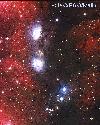
Date: 1992.
Description: NGC 6914 and a group of reflection nebulae. PDF (with text).
Copyright: Malin-IAC-RGO.
Technical information:
Photographic 3-colour composition from the
Isaac Newton Telescope.
1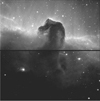 2
2
Description: The Horse Head Nebula. This dark dust
nebula, in the shape of a horse's head, protrudes into a bright emission
nebula, IC 434, in the constellation Orion. A nearby naked-eye star
illuminates the surface of an otherwise invisible dusty cloud, exciting the
distinctive red emission from hydrogen. From this dark cloud projects yet
more dust, which has the shape of the head of a horse, seen in silhouette
against the glowing background.
Date: Image 1: 1999, Image 2: 1997.
Credit: Image 1 is credit Simon Tulloch (ING) and Nik Szymanek (SPA).
Image 2 is
credit Peter Bunclark (IoA).
Technical information: Image 1 is a 10s exposure using the 2-detector
prime focus camera on the WHT. Image 2 is the same object as observed by the INT Wide Field
Camera.
Available formats: Image 1 JPEG (343 K) | PDF (with text).

Description: NGC 281 and IC 1590. NGC 281 is a busy workshop of star
formation. Prominent features include a small open cluster of stars, a
diffuse red-glowing emission nebula, large lanes of obscuring gas and dust,
and dense knots of dust and gas in which stars may still be forming. PDF (with text).
Date: 1992.
Copyright: Malin-IAC-RGO.
Technical information: This image is the result of combining 30
minute photographs taken at the INT prime focus in 3 different filters
matching the standard B,V,R system.

Description:
This image is a new planetary nebula discovered by the INT/WFC Photometric Hydrogen-Alpha Survey of the Northern Galactic Plane (IPHAS).
The
nebula was confirmed to be a relatively old planetary nebula using the ISIS spectrograph on the William Herschel Telescope.
Date: 2007.
Credits:Laurence Sabin, Nick Wright and the IPHAS collaboration.
Technical information: Image obtained using the Wide-Field Camera on the Isaac Newton Telescope. It is a two-colour image, red for H-alpha and green for [OIII]. North is to the right and East is to the top.
Available formats:
JPEG | TIFF | PDF (with text).

Description:
The central star of Sharpless 2-188 is 850 light years away and it is
travelling at 125 kilometres per second across the sky. Observations show a
strong brightening in the direction in which the star is moving and faint
material stretching away in the opposite direction. The astronomers believe that
the bright structures in the arc observed ahead of Sharpless 2-188 are the
bowshock instabilities revealed in the simulations, which will form
whirlpools as they spiral past the star downstream to the tail.
This image was obtained as part of the INT/WFC Photometric Hydrogen-Alpha Survey of the Northern Galactic Plane (IPHAS).
Date: 2007.
Credits: Nick Wright (University College London) and the IPHAS collaboration.
Technical information: Image obtained using the Wide-Field Camera on the Isaac Newton Telescope.
Available formats:
JPEG | BMP | PDF (with text).

Title: Planetary Nebula NGC 7293 or Helix Nebula.
Description:
Image of the planetary nebula NGC 7293.
Date: 2001.
Credit: Romano Corradi (ING).
Technical information: Image obtained with the
Wide Field Camera at the 2.5m INT telescope. A narrow filter
has been used to isolate the emission from the nebular gas in the hydrogen
Halpha line (at wavelength 656 nm) and in the nitrogen doublet [NII] at
lambda 655 and 658 nm.
Available formats: JPEG (66 K) | TIFF (2936 K)
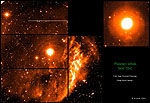
Title: Planetary Nebula NGC 3242.
Description:
Image of the planetary nebula NGC 3242.
Date: 2001.
Credit: Romano Corradi (ING).
Technical information: Image obtained with the
Wide Field Camera at the 2.5m INT telescope. A narrow filter
has been used to isolate the emission from the nebular gas in the hydrogen
Halpha line (at wavelength 656 nm) and in the nitrogen doublet [NII] at
lambda 655 and 658 nm.
Available formats: JPEG (316 K) | TIFF (13,175 K)
1 2
2 3
3
Title: Planetary Nebula Sh 2 - 200.
Description:
Image of the planetary nebula Sharpless 2-200. This is a very evolved
planetary nebula, whose central star has already
faded to a low luminosity after exhausting all circumnuclear fuel. Around
the filamentary inner nebula, a large faint halo is observed. This halo
might be interstellar gas ionized by the central star of the planetary
nebula, or alternatively ancient material
ejected by the star itself when it was a red giant some 50 to 100 thousand
years ago. These haloes provide very precious information about the
various events of strong mass loss at the end of life of solar type stars.
These mass loss events are the ultimate cause leading to the death of
these stars.
Date: Image 1, 2, 3: 2001.
Credit: Image 1: Romano Corradi (ING) and Nik Szymanek. Image 2:
Romano Corradi (ING). Image 3: Romano Corradi (ING) and Nik Szymanek.
Technical information: Images 1, 2 and 3 were obtained with the
Wide Field Camera at the 2.5m INT telescope. A narrow filter
has been used to isolate the emission from the nebular gas in the hydrogen
Halpha line (at wavelength 656 nm) and in the nitrogen doublet [NII] at
lambda 655 and 658 nm.
Available formats:
Image 1: JPEG (593 K) | TIFF (3,038 K)
Image 2: JPEG (158 K) | TIFF (362 K)
Image 3: JPEG (180 K) | TIFF (14,276 K)

Title: M 76 or NGC 650. The Little Dumbell Nebula.
Description:M76 is among the fainter Messier objects. It is known under the names Little Dumbbell Nebula (the most common), Cork Nebula, Butterfly Nebula, and Barbell Nebula, and it was given two NGC numbers as it was suspected to be a double nebula with two components in contact, a hypothesis brought up by William Herschel, who numbered the "second component" H I.193 on November 12, 1787. NGC 651 is the North following (East) part of the nebula.
Date: 25 November 2001.
Credit: Thomas Hardy School.
Technical information: Site2 CCD on Jacobus Kapteyn Telescope. 2*300 second exposures in Harris V, B and R filters.
Available formats: JPEG (181 K) | TIFF (4097 K)
1 2
2
Description:
NGC 6543, nicknamed the Cat's Eye Nebula, is one of the most complex of
the planetary class nebula, stars that throw of spheres of gas at the end of
their lives. It is located in the constellation Draco and is thought to have
been created 1000 years ago by two stars orbiting each other.
Date:
Image 1: August 2001.
Image 2: 2009.
Credit:
Image 1: Cornwall Astronomy School Project.
Image 2: Daniel López and Rafael Barrena (IAC).
Technical information:
Image 1: This B, V, R image was taken using the Jacobus Kapteyn telescope and the SITe2 detector.
Image 2: This image of the Cat's Eye Nebula or NGC 6543 was obtained using the Wide Field Camera on the Isaac Newton Telescope.
It is a three-colour composite made from data collected using filters to isolate the light emitted by hydrogen alpha (H-alpha), doubly ionised oxygen (OIII) and ionised sulfur (SII) atoms, and coded in the image as red, green and blue respectively. More information.
Available formats:
Image 1: JPEG (93 K) | TIFF (2M).
Image 2: JPEG | TIFF | PDF (with text) | PDF (poster with text).
1 2
2 3
3
Description:
M57 planetary nebula, also known as the "Ring Nebula". The famous ring
nebula M57 is often regarded as the prototype of a planetary nebula,
and a showpiece in the northern hemisphere summer sky. Recent research has
confirmed that it is, most probably, actually a ring (torus) of bright
light-emitting
material surrounding its central star, and not a spherical (or ellipsoidal) shell.
Date:
Image 1: 1999.
Image 2: 1995.
Image 3: 2009.
Credit:
Image 1: Daniel Folha and Simon Tulloch (ING).
Image 2: ING
Archive and Nik Szymanek.
Image 3: Daniel López (IAC).
Technical information:
Image 1: This true-colour
image was taken using the Jacobus Kapteyn telescope and the SITe2
detector.
Image 2: Jacobus Kapteyn Telescope, Tek CCD, B, V and R filters.
Image 3: Isaac Newton Telescope, Wide Field Camera. Filters: H-alpha, OIII and SII. More information.
Available formats:
Image 1: JPEG (49 K).
Image 2: JPEG (59 K) | TIFF(11,746 K).
Image 3: JPEG | TIFF | PDF (with text) | PDF (poster with text).

Description: NGC 3242 planetary nebula. The "Ghost of Jupiter" is a
planetary nebula which has a nearly spherical outer shell with an elliptical
inner ring that gives it the
appearance of an "eye". In this image it's also possible to see the
central illuminating star.
Date: 2000.
Credit: Javier Méndez (ING).
Technical information: Image acquired with the Auxiliary Port Camera
on the WHT, through filter R. Exposure time was 100 seconds.
Available formats: GIF (92 K)

Decription: M2-9 planetary nebula. M2-9, a butterfly planetary
nebula 2100 light-years away, has wings that tell a strange but incomplete tale. In
the center, two stars orbit inside a gaseous disk 10 times
the orbit of Pluto. The expelled envelope of the dying star breaks out from
the disk creating the bipolar appearance.
Date: 2000.
Credit: Javier Méndez (ING).
Technical information: Image acquired with the Auxiliary Port Camera
on the WHT, through filter R. Exposure time was 100 seconds.
Available formats: GIF (94 K)
1 2
2 3
3 4.
4.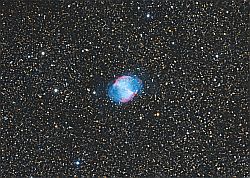
Title: M27, NGC 6853, the Dumbell nebula.
Description: The Dumbell nebula
was the first planetary nebula ever discovered. We happen to see this one
approximately from its equatorial plane; from near one pole, it would
probably have the shape of a ring, and perhaps look like we view the Ring
Nebula M57.
Credit: Image 1: Copyright Malin-IAC-RGO. Image 2: Amanda Willmott,
Aaron Shrimpton and Javier Méndez. Image 3: Amanda Willmott, Aaron
Shrimpton, Javier Méndez and Nik Szymanek. 4: Abel de Burgos Sierra (ING).
Date: Image 1: 1992. Image 2: 2000. Image 3: 2000. 4: 2019.
Technical information:
Image 1 1: Photographic 3-colour composition from the
Isaac Newton Telescope. Image 2: True-colour composition from B, V, and R imaging using a CCD
camera on the JKT. Image 3: Same as before but colour-processed by Nik Szymanek.
4: Dumbell Nebula
Available formats: Image 1: PDF (with text). Image 2: JPEG (248 K) | Compressed TIFF (9,177 K). Image 3: JPEG
(109 K) | TIFF (14,392 K). 4: Dumbell Nebula
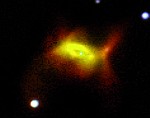
Decription: The "Príncipes de Asturias" nebula or IPHAS PN-1. The discovery of the first new PN from the IPHAS survey is an unusual object located at a
large galactocentric distance and has a very low oxygen abundance. The so-called "Príncipes de Asturias" nebula shows an intricate morphology: there is an
inner ring surrounding the central star, bright inner lobes with an enhanced waist, and very faint lobular extensions reaching up to more than 100 arcseconds.
Date: 2006.
Credit: Credit: Antonio Mampaso, Romano Corradi and the IPHAS Collaboration.
Technical information: Image acquired using the Wide-field Camera on the Isaac Newton Telescope.
Available formats: JPEG | TIFF
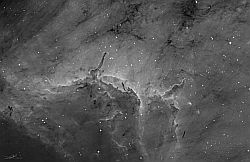
Decription: The Pelican Nebula.
Date: 2019.
Credit: Credit: ING support astronomers.
Technical information: Image acquired using the Wide-field Camera on the Isaac Newton Telescope.
Available formats: PNG

Decription: Orion Constellation.
Date: 2019.
Credit: Credit: Abel de Burgos (ING).
Technical information: Canon EOS 6D MarkI.
Available formats: PNG


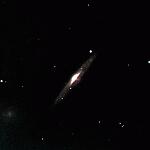
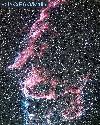 2
2
 2
2

















































